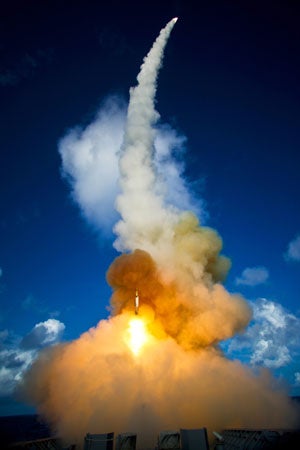This week, The Heritage Foundation hosted an eventto celebrate “The 10th Anniversary of the Anti-Ballistic Missile Treaty Withdrawal.”
This 1972 treaty kept America at risk to a ballistic missile attack. Despite the withdrawal, the danger remains grave, because a missile launched anywhere in the world can reach the U.S. homeland in 33 minutes.
The Heritage Foundation was honored to bring together some of the foremost experts on this issue. Ambassador Robert Joseph, former Under Secretary of State for Arms Control and International Security, and John Rood, former Acting Under Secretary of State for Arms Control and International Security, delivered keynote remarks focused on lessons learned from the withdrawal from the treaty, to which both of them were instrumental.
It is essential to debunk myths surrounding the treaty, such as that the withdrawal would cause an arms race. It has not—and the treaty itself has not prevented an arms race, as the U.S. and Soviet nuclear arsenals grew exponentially after the treaty entered into force.
Douglas Feith, director of the National Security Strategies Center at the Hudson Institute and former Under Secretary of Defense, pointed out that the moral argument for withdrawal from the treaty was made when President Reagan refused to perpetuate U.S. and allied vulnerability in the face of the Soviet threat.
The Honorable Stephen Rademaker, principal of the Podesta Group and former Assistant Secretary of State for Arms Control and Nonproliferation, pointed out that the treaty was a hard case that made bad law. During the 1990s, the Clinton Administration tried, and ultimately failed, to transform the treaty to adopt it to a post–Cold War environment. However, the treaty itself became an impediment to the arms control process itself due to Clinton’s effort to keep the agreement alive.
The Obama Administration has not been able to bring into force any nuclear arms control treaty. According to Mark Groombridge, vice president of Global Communicators and former advisor to the Under Secretary of State for Arms Control, it was essential to get the process of withdrawal right, because it forced people to engage on the substance of the treaty. This provided many opportunities to further demystify the treaty.
Alison Fortier, vice president of missile defense at the Lockheed Martin Corporation, and Mira Ricardel, vice president of business development, strategic missile, and defense systems at the Boeing Company, spoke about advances in the missile defense program that the industry was able to achieve since the U.S. withdrew from the treaty.
All of the participants shared concerns that the battle over whether the U.S. protects its people and allies from a ballistic missile threat is not over yet. President Obama’s missile defense policies—such as the cancellation of the Multiple Kill Vehicle, Kinetic Energy Interceptor, and Airborne Laser programs—signal his lack of commitment to the protection of the U.S. homeland.
In addition, looming sequestration does not provide the certainty in which the business sector can plan for the future and operate. Yet President Obama said that he would veto any legislation that would prevent sequestration. The strategic environment is growing more uncertain, and U.S. enemies are growing bolder. This is not the time to cut U.S. defenses.
